Apps
Auto Added by WPeMatico
Auto Added by WPeMatico
Spotify is expanding the capabilities of its parental controls on its Spotify Kids app, aimed at children ages 3 and up on a parent’s Spotify Premium Family plan. Before, parents could only select whether the child was directed to the experience for younger or older children. Now, they’ll be able to specifically block content from their child’s account when accessing the child’s listening history.
These features had been hinted at when Spotify Kids made its U.S. debut in March. At the time, Spotify said it heard from parents testing the app in other markets how they wanted to have even more control over the app’s included content. Though the company didn’t detail its plans then, it did say new features would involve allowing parents making more specific choices over what their child could stream.
Both new features are now included in the PIN-protected “Grown Ups” section, previously called the “Parental Settings.” Once there, a parent can select which child’s account they want to to update or view.
The Listening History option will allow them to view every track the child has streamed on the Spotify Kids app over the past three months. From here, a parent can also opt to select a track and block it by tapping the “block” icon next to the track in question.
These blocked tracks are then removed from the child’s account and can’t be streamed. However, parents can unblock the track further down the road if they choose, by accessing either the Listening History section or the Blocked Tracks section and tapping the red icon next to each track.
Spotify says these new features are the first step in many planned updates for its Kids application, which today includes more than 8,000 kid-appropriate songs, stories, audiobooks and sounds that are curated into 125+ playlists. Though the app is aimed at kids young and old, many children will age out of it around their tweens, despite its support for an “older kids” experience. That’s because kids have established some favorite artists and musical preferences by then, and the more limited catalog on Spotify Kids doesn’t deliver. Plus, the downside of hand-curation means newly emerging hits — like, say, those blowing up on TikTok — may not make an appearance on Spotify Kids until later.
While it makes sense that Spotify would focus more immediately on parental controls catering to parents of the younger children, in time being able to go the other direction — perhaps a whitelisting option or the import of pre-approved playlists — would be appreciated by parents of older kids.
The Spotify Kids app is now live across 14 global markets, including as of today, Japan and Germany.
Powered by WPeMatico
Welcome back to This Week in Apps, the Extra Crunch series that recaps the latest OS news, the applications they support and the money that flows through it all.
The app industry is as hot as ever, with a record 204 billion downloads and $120 billion in consumer spending in 2019. People are now spending 3 hours and 40 minutes per day using apps, rivaling TV. Apps aren’t just a way to pass idle hours — they’re a big business. In 2019, mobile-first companies had a combined $544 billion valuation, 6.5x higher than those without a mobile focus.
In this Extra Crunch series, we help you keep up with the latest news from the world of apps, delivered on a weekly basis.
This week we’re continuing to look at how the coronavirus outbreak is impacting the world of mobile applications, including the latest on countries’ various contact-tracing apps, the pandemic’s impact on gaming and fintech and more. We’re also looking at that big app crash caused by Facebook, plus new app releases from Facebook and Google, Android 11’s new timeline and Apple’s plans to move WWDC online, among other things.
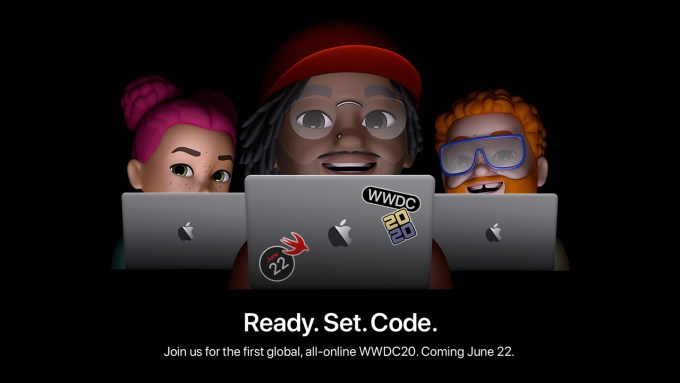
Apple announced this week its plans for a virtual version of its Worldwide Developer Conference. The company will host its WWDC 2020 event beginning on June 22 in the Apple Developer app and on the Apple Developer website for free for all developers.
It will be interesting to see how successfully Apple is able to take its developer conference online. After all, developers could already access the sessions and keynotes through videos — but the real power of the event was in the networking and being able to talk to Apple engineers, ask questions, get hands-on help and see how other developers are using Apple technologies to innovate. Unless Apple is planning a big revamp of its developer site and app that would enable those connections, it seems this year’s event will lack some of WWDC’s magic.
The company also announced the Swift Student Challenge, an opportunity for student developers to showcase their coding by creating their own Swift playground.
Powered by WPeMatico
Google today launched an update to its Duo video chat app (which you definitely shouldn’t confuse with Hangouts or Google Meet, Google’s other video, audio and text chat apps).
There are plenty of jokes to be made about Google’s plethora of chat options, but Duo is trying to be a bit different from Hangouts and Meet in that it’s mobile-first and putting the emphasis on personal conversations. In its early days, it was very much only about one-on-one conversations (hence its name), but that has obviously changed (hence why Google will surely change its name sooner or later). This update shows this emphasis with the addition of what the company calls a “family mode.”
 Once you activate this mode, you can start doodling on the screen, activate a number of new effects and virtually dress up with new masks. These effects and masks are now also available for one-on-one calls.
Once you activate this mode, you can start doodling on the screen, activate a number of new effects and virtually dress up with new masks. These effects and masks are now also available for one-on-one calls.
For Mother’s Day, Google is rolling out a special new effect that is sufficiently disturbing to make sure your mother will never want to use Duo again and immediately make her want to switch to Google Meet instead.
Only last month, Duo increased the maximum number of chat participants to 12 on Android and iOS. In the next few weeks, it’s also bringing this feature to the browser, where it will work for anyone with a Google account.
Google also launched a new ad for Duo. It’s what happens when marketers work from home.
Powered by WPeMatico
Acast, a podcast monetization and distribution platform, announced a new partnership with JioSaavn, one of the largest streaming audio services in India. The agreement mean JioSaavn will distribute content from Acast and have access to its technology for podcasters.
JioSaavn, which claims 104 million monthly active users, is the second-largest streaming audio service in India after Gaana, and holds about 24% market share, according to an OTT Audience Measurement Insights report.
Podcasts from Acast’s network will be added to JioSaavn’s streaming app over the next two months. Based in Sweden, Acast focuses on developing ways to help podcasters monetize, including subscription paywalls and dynamic ads. Publishers on Acast’s network include the Guardian, BBC, the Financial Times and PBS NewsHour.
JioSaavn launched original programming in 2016, including JioSaavn podcasts, which it says now has more than 200 hours of original content.
In a press statement, Ishani Dasgupta, JioSaavn’s lead of podcast partnerships, said, “Podcasting is still largely nascent to consumers in the Indian market, with momentum growing quickly. The ability to grow and build new audiences, new shows and establish pathways for brands to access both is really just beginning for our 1.3 billion potential consumer market.”
Powered by WPeMatico
If you’ve ever been stuck using a health provider’s clunky online patient portal or had to make multiple calls to transfer medical records, you know how difficult it is to access your health data.
In an era when control over personal data is more important than ever before, the healthcare industry has notably lagged behind — but that’s about to change. This past month, the U.S. Department of Health and Human Services (HHS) published two final rules around patient data access and interoperability that will require providers and payers to create APIs that can be used by third-party applications to let patients access their health data.
This means you will soon have consumer apps that will plug into your clinic’s health records and make them viewable to you on your smartphone.
Critics of the new rulings have voiced privacy concerns over patient health data leaving internal electronic health record (EHR) systems and being surfaced to the front lines of smartphone apps. Vendors such as Epic and many health providers have publicly opposed the HHS rulings, while others, such as Cerner, have been supportive.
While that debate has been heated, the new HHS rulings represent a final decision that follows initial rules proposed a year ago. It’s a multi-year win for advocates of greater data access and control by patients.
The scope of what this could lead to — more control over your health records, and apps on top of it — is immense. Apple has been making progress with its Health Records app for some time now, and other technology companies, including Microsoft and Amazon, have undertaken healthcare initiatives with both new apps and cloud services.
It’s not just big tech that is getting in on the action: startups are emerging as well, such as Commure and Particle Health, which help developers work with patient health data. The unlocking of patient health data could be as influential as the unlocking of banking data by Plaid, which powered the growth of multiple fintech startups, including Robinhood, Venmo and Betterment.
What’s clear is that the HHS rulings are here to stay. In fact, many of the provisions require providers and payers to provide partial data access within the next 6-12 months. With this new market opening up, though, it’s time for more health entrepreneurs to take a deeper look at what patient data may offer in terms of clinical and consumer innovation.
Powered by WPeMatico
A UK parliamentary committee that focuses on human rights issues has called for primary legislation to be put in place to ensure that legal protections wrap around the national coronavirus contact tracing app.
The app, called NHS COVID-19, is being fast tracked for public use — with a test ongoing this week in the Isle of Wight. It’s set to use Bluetooth Low Energy signals to log social interactions between users to try to automate some contacts tracing based on an algorithmic assessment of users’ infection risk.
The NHSX has said the app could be ready for launch within a matter of weeks but the committee says key choices related to the system architecture create huge risks for people’s rights that demand the safeguard of primary legislation.
“Assurances from Ministers about privacy are not enough. The Government has given assurances about protection of privacy so they should have no objection to those assurances being enshrined in law,” said committee chair, Harriet Harman MP, in a statement.
“The contact tracing app involves unprecedented data gathering. There must be robust legal protection for individuals about what that data will be used for, who will have access to it and how it will be safeguarded from hacking.
“Parliament was able quickly to agree to give the Government sweeping powers. It is perfectly possible for parliament to do the same for legislation to protect privacy.”
The NHSX, a digital arm of the country’s National Health Service, is in the process of testing the app — which it’s said could be launched nationally within a few weeks.
The government has opted for a system design that will centralize large amounts of social graph data when users experiencing COVID-19 symptoms (or who have had a formal diagnosis) choose to upload their proximity logs.
Earlier this week we reported on one of the committee hearings — when it took testimony from NHSX CEO Matthew Gould and the UK’s information commissioner, Elizabeth Denham, among other witnesses.
Warning now over a lack of parliamentary scrutiny — around what it describes as an unprecedented expansion of state surveillance — the committee report calls for primary legislation to ensure “necessary legal clarity and certainty as to how data gathered could be used, stored and disposed of”.
The committee also wants to see an independent body set up to carry out oversight monitoring and guard against ‘mission creep’ — a concern that’s also been raised by a number of UK privacy and security experts in an open letter late last month.
“A Digital Contact Tracing Human Rights Commissioner should be responsible for oversight and they should be able to deal with complaints from the Public and report to Parliament,” the committee suggests.
Prior to publishing its report, the committee wrote to health minister Matt Hancock, raising a full spectrum of concerns — receiving a letter in response.
In this letter, dated May 4, Hancock told it: “We do not consider that legislation is necessary in order to build and deliver the contact tracing app. It is consistent with the powers of, and duties imposed on, the Secretary of State at a time of national crisis in the interests of protecting public health.”
The committee’s view is Hancock’s ‘letter of assurance’ is not enough given the huge risks attached to the state tracking citizens’ social graph data.
“The current data protection framework is contained in a number of different documents and it is nearly impossible for the public to understand what it means for their data which may be collected by the digital contact tracing system. Government’s assurances around data protection and privacy standards will not carry any weight unless the Government is prepared to enshrine these assurances in legislation,” it writes in the report, calling for a bill that it says myst include include a number of “provisions and protections”.
Among the protections the committee is calling for are limits on who has access to data and for what purpose.
“Data held centrally may not be accessed or processed without specific statutory authorisation, for the purpose of combatting Covid-19 and provided adequate security protections are in place for any systems on which this data may be processed,” it urges.
It also wants legal protections against data reconstruction — by different pieces of data being combined “to reconstruct information about an individual”.
The report takes a very strong line — warning that no app should be released without “strong protections and guarantees” on “efficacy and proportionality”.
“Without clear efficacy and benefits of the app, the level of data being collected will be not be justifiable and it will therefore fall foul of data protection law and human rights protections,” says the committee.
The report also calls for regular reviews of the app — looking at efficacy; data safety; and “how privacy is being protected in the use of any such data”.
It also makes a blanket call for transparency, with the committee writing that the government and health authorities “must at all times be transparent about how the app, and data collected through it, is being used”.
A lack of transparency around the project was another of the concerns raised by the 177 academics who signed the open letter last month.
The government has committed to publishing data protection impact assessments for the app. But the ICO’s Denham still hadn’t had sight of this document as of this Monday.
Another call by the committee is for a time-limit to be attached to any data gathered by or generated via the app. “Any digital contact tracing (and data associated with it) must be permanently deleted when no longer required and in any event may not be kept beyond the duration of the public health emergency,” it writes.
We’ve reached out to the Department of Health and NHSX for comment on the human rights committee’s report.
Let’s go through Matt Hancock’s letter to @HarrietHarman @HumanRightsCtte on the NHSX app and take a closer look at some of these statements 1/ https://t.co/sQe2U8wkiy
— Michael Veale (@mikarv) May 7, 2020
There’s another element to this fast moving story: Yesterday the Financial Times reported that the NHSX has inked a new contract with an IT supplier which suggests it might be looking to change the app architecture — moving away from a centralized database to a decentralized system for contacts tracing. Although NHSX has not confirmed any such switch at this point.
Some other countries have reversed course in their choice of app architecture after running into technical challenges related to Bluetooth. The need to ensure public trust in the system was also cited by Germany for switching to a decentralized model.
The human rights committee report highlights a specific app efficacy issue of relevance to the UK, which it points out is also linked to these system architecture choices, noting that: “The Republic of Ireland has elected to use a decentralised app and if a centralised app is in use in Northern Ireland, there are risks that the two systems will not be interoperable which would be most unfortunate.”
Professor Lilian Edwards, a legal expert from Newcastle University, who has co-authored a draft bill proposing a set of safeguards for coronavirus apps (much of which was subsequently taken up by Australia for a legal instrument that wraps public health contact info during the coronavirus crisis) — and who also now sits as an independent advisor on an ethics committee that’s been set up for the NHSX app — welcomed the committee report.
Speaking in a personal capacity she told TechCrunch: “My team and I welcome this.”
But she flagged a couple of omissions in the report. “They have left out two of the recommendations from my bill — one of which, I totally expected; that there be no compulsion to carry a phone. Because they will just be assumed within our legal system but I don’t think it would have hurt to have said it. But ok.
“The second point — which is important — is the point about there not being compulsion to install the app or to display it. And there not being, therefore, discrimination against you if you don’t. Like not being allowed to go to your workplace is an obvious example. Or not being allowed to go to a football game when they reopen. And that’s the key point where the struggle is.”
The conflict, says Edwards, is on the one hand you could argue what’s the point of doing digital contact tracing at all if you can’t make sure people are able to receive notifications that they might be a contact. But — on the other — if you allow compulsion that then “leaves it open to be very discriminatory” — meaning people could abuse the requirement to target and exclude others from a workplace, for example.
“There are people who’ve got perfectly valid reasons to not want to have this on their phone,” Edwards added. “Particularly if it’s centralized rather than decentralized.”
She also noted that the first version of her draft coronavirus safeguards bill had allowed compulsion re: having the app on the phone but required it to be balanced by a proportionality analysis — meaning any such compulsion must be “proportionate to a legitimate aim”.
But after Australia opted for zero compulsion in its legal instrument she said she and her team decided to revise their bill to also strike out the provision entirely.
Edwards suggested the human rights committee may not have included this particular provision in their recommendations because parliamentary committees are only able to comment on evidence they receive during an inquiry. “So I don’t think it would have been in their remit to recommend on that,” she noted, adding: “It isn’t actually an indication that they’re not interested in these concepts; it’s just procedure I think.”
She also highlighted the issues of so-called ‘immunity passports’ — something the government has reportedly been in discussions with startups about building as part of its digital coronavirus response, but which the committee report also does not touch on.
However, without full clarity on the government’s evolving plans for its digital coronavirus response, and with, inevitably, a high degree of change and flux amid a public health emergency situation, it’s clearly difficult for committees to interrogate so many fast moving pieces.
“The select committees have actually done really, really well,” added Edwards. “But it just shows how the ground has shifted so much in a week.”
This report was updated with additional comment
Powered by WPeMatico
The UK may be rethinking its decision to shun Apple and Google’s API for its national coronavirus contacts tracing app, according to the Financial Times, which reported yesterday that the government is paying an IT supplier to investigate whether it can integrate the tech giants’ approach after all.
As we’ve reported before coronavirus contacts tracing apps are a new technology which aims to repurpose smartphones’ Bluetooth signals and device proximity to try to estimate individuals’ infection risk.
The UK’s forthcoming app, called NHS COVID-19, has faced controversy because it’s being designed to use a centralized app architecture. This means developers are having to come up with workarounds for platform limitations on background access to Bluetooth as the Apple-Google cross-platform API only works with decentralized systems.
The choice of a centralized app architecture has also raised concerns about the impact of such an unprecedented state data grab on citizens’ privacy and human rights, and the risk of state ‘mission creep‘.
The UK also looks increasingly isolated in its choice in Europe after the German government opted to switch to a decentralized model, joining several other European countries that have said they will opt for a p2p approach, including Estonia, Ireland and Switzerland.
In the region, France remains the other major backer of a centralized system for its forthcoming coronavirus contacts tracing app, StopCovid.
Apple and Google, meanwhile, are collaborating on a so-called “exposure notification” API for national coronavirus contacts tracing apps. The API is slated to launch this month and is designed to remove restrictions that could interfere with how contact events are logged. However it’s only available for apps that don’t hold users’ personal data on central servers and prohibits location tracking, with the pair emphasizing that their system is designed to put privacy at the core.
Yesterday the FT reported that NHSX, the digital transformation branch of UK’s National Health Service, has awarded a £3.8M contract to the London office of Zuhlke Engineering, a Switzerland-based IT development firm which was involved in developing the initial version of the NHS COVID-19 app.
The contract includes a requirement to “investigate the complexity, performance and feasibility of implementing native Apple and Google contact tracing APIs within the existing proximity mobile application and platform”, per the newspaper’s report.
The work is also described as a “two week timeboxed technical spike”, which the FT suggests means it’s still at a preliminary phase — thought it also notes the contract includes a deadline of mid-May.
The contracted work was due to begin yesterday, per the report.
We’ve reached out to Zuhlke for comment. Its website describes the company as “a strong solutions partner” that’s focused on projects related to digital product delivery; cloud migration; scaling digital platforms; and the Internet of Things.
We also put questions arising from the FT report to NHSX.
At the time of writing the unit had not responded but yesterday a spokesperson told the newspaper: “We’ve been working with Apple and Google throughout the app’s development and it’s quite right and normal to continue to refine the app.”
The specific technical issue that appears to be causing concern relates to a workaround the developers have devised to try to circumvent platform limitations on Bluetooth that’s intended to wake up phones when the app itself is not being actively used in order that the proximity handshakes can still be carried out (and contacts events properly logged).
Thing is, if any of the devices fail to wake up and emit their identifiers so other nearby devices can log their presence there will be gaps in the data. Which, in plainer language, means the app might miss some close encounters between users — and therefore fail to notify some people of potential infection risk.
Recent reports have suggested the NHSX workaround has a particular problem with iPhones not being able to wake up other iPhones. And while Google’s Android OS is the more dominant platform in the UK (running on circa ~60% of smartphones, per Kantar) there will still be plenty of instances of two or more iPhone users passing near each other. So if their apps fail to wake up they won’t exchange data and those encounters won’t be logged.
On this, the FT quotes one person familiar with the NHS testing process who told it the app was able to work in the background in most cases, except when two iPhones were locked and left unused for around 30 minutes, and without any Android devices coming within 60m of the devices. The source also told it that bringing an Android device running the app close to the iPhone would “wake up” its Bluetooth connection.
Clearly, the government having to tell everyone in the UK to use an Android smartphone not an iPhone wouldn’t be a particularly palatable political message.
This is effectively a form of Android Herd Immunity: for the good of Britain, vaccinate your friends by giving them Androids!
— Michael Veale (@mikarv) May 5, 2020
One source with information about the NHSX testing process told us the unit has this week been asking IT suppliers for facilities or input on testing environments with “50-100 Bluetooth devices of mixed origin”, to help with challenges in testing the Bluetooth exchanges — which raises questions about how extensively this core functionality has been tested up to now. (Again, we’ve put questions to the NHSX about testing and will update this report with any response.)
Work on planning and developing the NHS COVID-19 app began March 7, according to evidence given to a UK parliamentary committee by the NHSX CEO’s, Matthew Gould, last month.
Gould has also previously suggested that the app could be “technically” ready to launch in as little as two or three weeks time from now. While a limited geographical trial of the app kicked off this week in the Isle of Wight. Prior to that, an alpha version of the app was tested at an RAF base involving staff carrying out simulations of people going shopping, per a BBC report last month.
Gould faced questions over the choice of centralized vs decentralized app architecture from the human rights committee earlier this week. He suggested then that the government is not “locked” to the choice — telling the committee: “We are constantly reassessing which approach is the right one — and if it becomes clear that the balance of advantage lies in a different approach then we will take that different approach. We’re not irredeemably wedded to one approach; if we need to shift then we will… It’s a very pragmatic decision about what approach is likely to get the results that we need to get.”
However it’s unclear how quickly such a major change to app architecture could be implemented, given centralized vs decentralized systems work in very different ways.
Additionally, such a big shift — more than two months into the NHSX’s project — seems, at such a late stage, as if it would be more closely characterized as a rebuild, rather than a little finessing (as suggested by the NHSX spokesperson’s remark to the FT vis-a-vis ‘refining’ the app).
In related news today, Reuters reports that Colombia has pulled its own coronavirus contacts tracing app after experiencing glitches and inaccuracies. The app had used alternative technology to power contacts logging via Bluetooth and wi-fi. A government official told the news agency it aims to rebuild the system and may now use the Apple-Google API.
Australia has also reported Bluetooth related problems with its national coronavirus app. And has also been reported to be moving towards adopting the Apple-Google API.
While, Singapore, the first country to launch a Bluetooth app for coronavirus contacts tracing, was also the first to run into technical hitches related to platform limits on background access — likely contributing to low download rates for the app (reportedly below 20%).
Powered by WPeMatico
Meet Kairn, a new startup coming out of stealth today with a sneak peek of what the company has been working on. As Wunderlist shuts down, Kairn wants to prove that there’s still room for an innovative task-management service.
“We’re building a task manager that is smart and focused on capturing tasks,” co-founder and CEO Patricia Bernasconi told me. The startup is backed by eFounders, a startup studio that has been building popular software-as-a-service startups over the past few years.
And it starts with three integrations with third-party services — Slack, WhatsApp and Gmail. If you star an email conversation in Gmail, it’ll automatically create a task in Kairn. Similarly, if you star a message in Slack, it’ll end up in your to-do list. With WhatsApp, you can forward a message to a bot to capture it in Kairn.
“You don’t have to switch apps constantly and you create tasks on the fly,” Bernasconi said.
And you can always trigger the Kairn quick add window on your computer to add a task when you’re using another app. The idea is that it should be as easy as possible to enter tasks in your task repository — Kairn in this case.

After that, you can open the main Kairn desktop app and dig through your task inbox to see what you should do. You can filter tasks by origin application and you can click on a task to look at the context of an email thread or a Slack message, for instance.
Kairn then lets you move tasks to the main list, “My Day.” It works pretty much like Wunderlist or Microsoft To Do — once per day, you can curate a list of tasks and then go through the list during your day.
The product is quite new, as the company started development in April — beta testing will start in the coming weeks. But the idea is to iterate quickly and release new features as soon as they’re ready.
For instance, the mobile app is still in the works. There will be more ways to add tasks in the future as well. You could imagine highlighting text in your browser to create a task based on that text selection.
Over time, Kairn wants to become a full-fledged task-management service. You’ll be able to assign tasks and use it for complex project management scenarios. We’ll keep an eye on the startup to see where they’re heading.
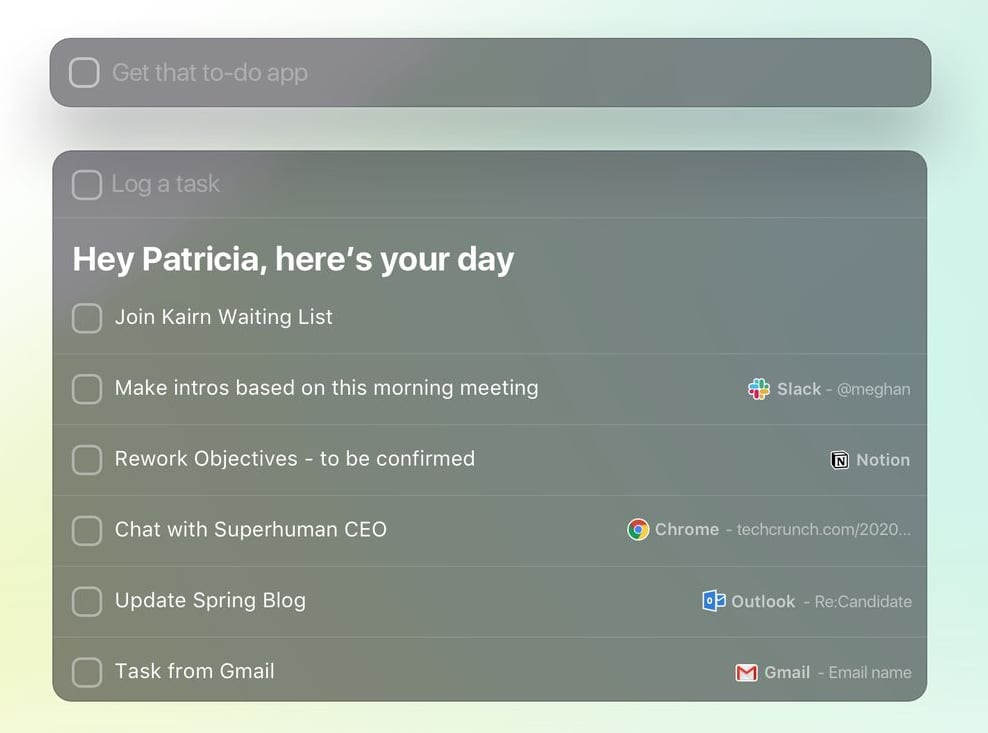
Powered by WPeMatico
Peanut, an app that began as a tool for finding new mom friends, has evolved into a social network now used by 1.6 million women to discuss a range of topics, from pregnancy and parenthood to marriage and menopause, and everything in between. On the heels of significant growth in online networking fueled by the COVID-19 pandemic, the company is today announcing the close of a $12 million Series A round of funding, led by EQT Ventures, a multi-stage VC firm that invests in companies across Europe and the U.S.
Index Ventures and Female Founders Fund also participated, bringing Peanut’s total raise to date to $21.8 million.
The round itself closed just weeks ago — arriving at a time when the coronavirus pandemic is impacting the startup world, often drying up venture capital for emerging companies. Some startups, as a result, have laid off employees to self-sustain, while others have sought exits or even folded.
Peanut, on the other hand, has seen rapid growth for its platform as women looked for a supportive online environment to discuss their own concerns over how COVID-19 was impacting their lives.
Many women participating in Peanut’s newer “Trying to Conceive” group, for example, worried about their canceled IVF rounds and how to plan for the future. Current moms-to-be wanted to hear from others about how COVID-19 would impact their hospital delivery plans. And others stuck working at home with kids looked for advice and coping strategies.
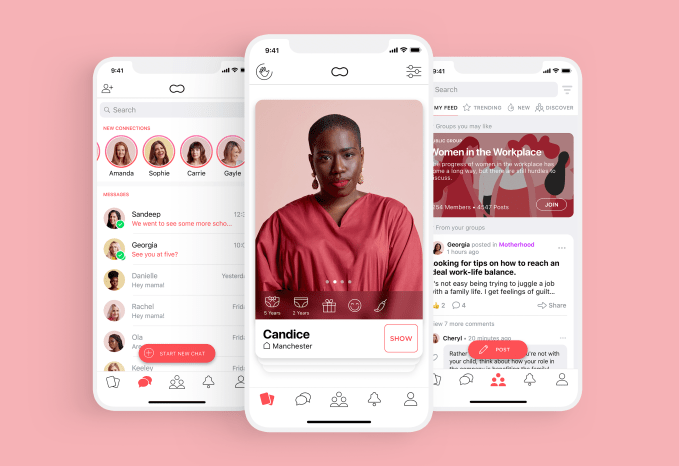
Since the outbreak, Peanut has seen engagement across its app increase by 30% and content consumption increase by 40%. Its total community also grew from 1 million users in December 2019 to now 1.6 million, as of April.
“We’re really lucky in that we’re growing and that we are, for the most part, untouched by what’s happening,” says Peanut founder and CEO Michelle Kennedy. “And actually, if anyone needed community more, it’s now,” she added.
Though the pandemic has sent the app’s usage skyrocketing, it has also readjusted Peanut’s priorities with regard to its roadmap.
Most notably, its friend-finding feature needs a rethink.
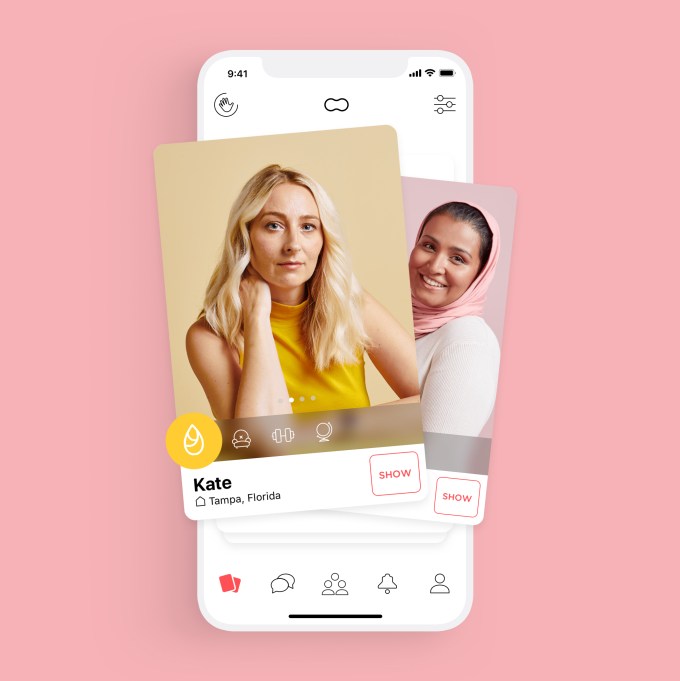
Peanut originally worked as a sort of “Tinder for mom friends” — an idea that arose from Kennedy’s personal experience with how difficult it was to forge female friendships after motherhood. As the former deputy CEO at dating app Badoo and an inaugural board member at Bumble, she brought her extensive experience in matchmaking apps to Peanut, which uses a similar swipe-based mechanism.
But COVID-19 has up-ended this side of Peanut’s business. Today, Peanut users are meeting in Zoom chat rooms to hangout or play games, but not in person.
Kennedy says the company will try to meet these users where they are with the development of more video networking features, potentially with technology built in-house. Other plans for the new capital include improvements to the social discovery aspects of its app, the development of a web version of Peanut, and the creation of more groups beyond those focused on fertility and motherhood, which have so far been core to the Peanut experience.
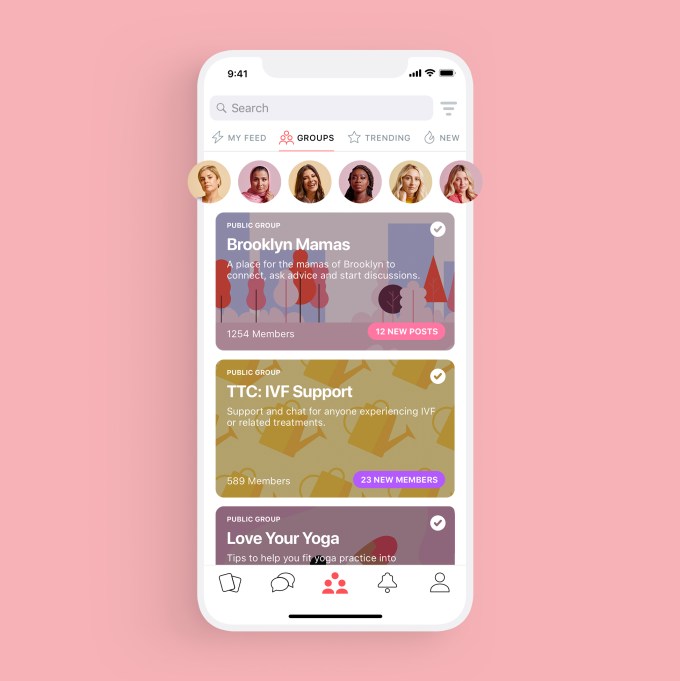
Specifically, the company soon plans to launch a new community focused on women living with menopause, an experience that will reach more than a billion women by 2025. Despite the fact that all women with ovaries will go through menopause, there are relatively few online communities dedicated to it — which Peanut sees as an untapped market.
Peanut’s real strength, however, is not in the types of communities it grows on its platform, but how they’re created.
There has not yet been a social network that focused on “building a platform for women, thinking about women’s needs and built by a women,” explains Kennedy. “So what we end up doing is using things that already exist — trying to twist them and mold them into what we need, and never getting it exactly right,” she says. “We can do better than that.”
One small example of this is the recent launch of Peanut’s “Mute Keywords” feature that allows women to remove certain types of discussions from their feeds and notifications. Some women used this to create a coronavirus-free news feed that focused on other aspects of motherhood. Others who were trying to conceive muted conversations around “pregnancy,” which they found emotionally triggering.
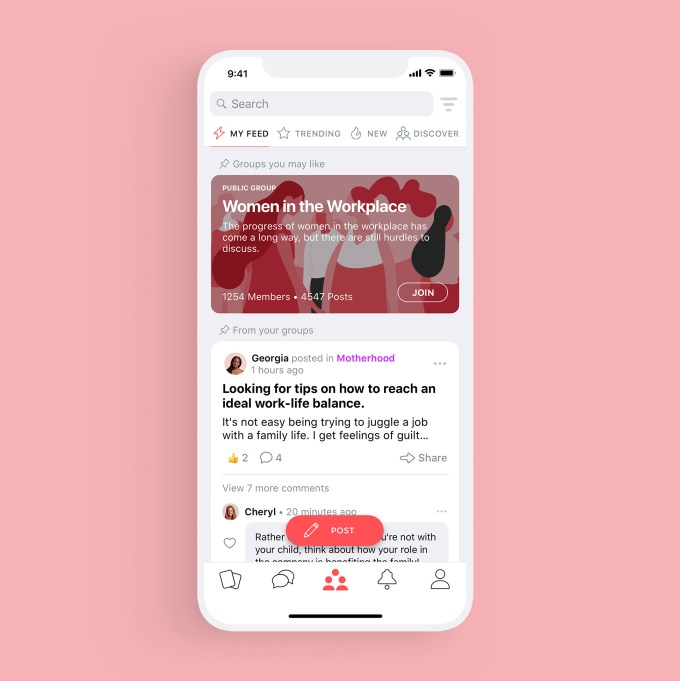
With the Series A’s close, Peanut says Naza Metghalchi from EQT Ventures joins the company’s majority-female board, alongside Hannah Seal from existing investor Index Ventures.
“Peanut’s user engagement metrics are a testament to the app’s ability to act as a true emotional companion throughout women’s journeys,” said Naza Metghalchi, venture lead and investment advisor at EQT Ventures, in a statement. “The EQT Ventures team is excited to partner with Michelle and continue to grow Peanut into a platform that serves all women at different life milestones, exploring topics beyond fertility and motherhood which have already seen such huge traction.”
The additional funding allows London-based Peanut to expand its business and hire more engineers to join its current team of just 16.
“I think having closed a round in this climate is great for the team,” says Kennedy. “It’s also great for the community because it means that we can grow the team, build quicker, build faster and develop the product more quickly,” she adds.
Powered by WPeMatico
There are some startups that behave like sprinters, and others that run a marathon. I came across Instabug when I was in Cairo in 2013. Born during the chaotic era of the Arab Spring, this plucky startup managed to make it to TechCrunch Disrupt, then Y Combinator in 2016, then a $1.7 million in seed round led by Accel Partners. Originally part of the Egyptian accelerator Flat6Labs Cairo, they raised $300,000 from angel investors in 2013.
Today they announced a $5 million Series A round, once again led by Accel . Other angel investors joining include Amr Awadallah, co-founder of Cloudera, and Jim Payne, founder and CEO of MoPub, both of whom have invested previously.
Instabug provides mobile developers with real-time insights throughout the app life cycle, with its bug and feedback reporting, secure crash reporting and in-app surveys. All the more important these days, given so many people are relying on apps during their pandemic lockdowns.
Omar Gabr, co-founder and CEO of Instabug, said in a statement: “We’ve been working with Accel since 2016 and we’re very excited to continue our partnership. We grew 120% in revenues in the last 12 months, adding dozens of Enterprise customers. We’ve always been running a disciplined business, we’re almost profitable for some time now. This is what made our fundraising fast in the middle of all the current events. Our fundraising conversations with Accel started after the pandemic outbreak.”
Instabug says that since the COVID-19 outbreak, it has seen a “massive surge” in usage, which has grown 45% since January. It’s also designed to streamline the communication between QA and developers, which is very relevant now, as many are working remotely.
Some 28 of the top 100 apps on the App Store use Instabug. Several competitors have been acquired, including Crashlytics (by Google) and HockeyApp (by Microsoft).
Given that the startup still has most of its team in Egypt, this is once again a great win for the MENA region.
Powered by WPeMatico